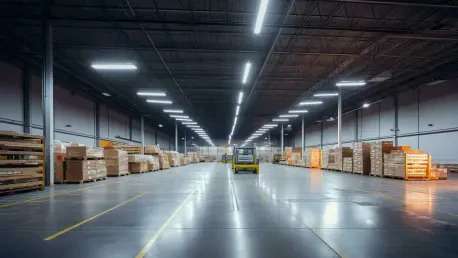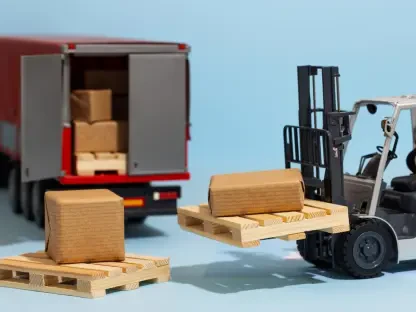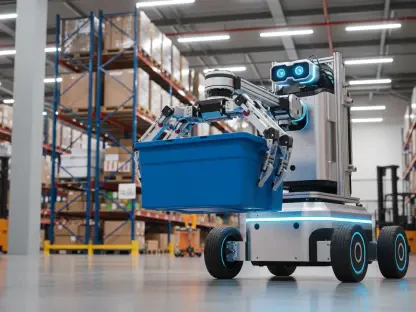In a rapidly evolving industry where optimizing storage and enhancing material handling are critical, Rohit Laila stands at the forefront of logistics innovation. With decades of experience in the supply chain sector, Rohit brings a wealth of knowledge, particularly around the intersection of technology and efficiency. His insights into the Aisle Master VNA range, a pioneering solution from Combilift, can reshape how warehousing operations are conducted, focusing on maximizing resource utilization and sustainability.
What are the key benefits of using the Aisle Master VNA range compared to traditional forklifts?
The Aisle Master VNA range simplifies operations by integrating the functions of several other forklift types, like counterbalance and reach trucks. Traditional systems often involve switching between trucks for different tasks, like moving loads from outdoors to indoors, which can lead to inefficiencies and potential product damage. The Aisle Master eliminates this need with its versatile capabilities, offering a seamless “truck to rack” operation which not only boosts productivity but also minimizes handling risks.
How does the Aisle Master VNA improve efficiency in warehousing operations?
This range significantly enhances efficiency by reducing the number of transfers needed during load handling. Its unique design allows for streamlined operations, where goods can be moved directly from the truck delivery point to their storage location. This reduces time spent in logistics and increases turnover speed, which is vital for maintaining a competitive edge in the warehousing industry.
Can you explain the main limitations of traditional reach and counterbalance trucks in warehousing?
Traditional reach trucks are often restricted to indoor uses due to their requirement for smooth, flat surfaces, while counterbalance trucks, better suited for outdoor tasks, can’t handle narrow indoor aisles efficiently. The need to switch between these trucks increases labor and time costs, restricts operational flexibility, and heightens the risk of product damage, all areas in which the Aisle Master excels with its multifunctionality.
How does the Aisle Master enable “truck to rack” capability, and why is this beneficial?
The “truck to rack” capability significantly enhances efficiency by allowing operators to transport products from outdoor delivery directly to their indoor storage locations without switching vehicles. This capability reduces handling steps, speeds up turnaround times, and cuts down on the time and costs associated with managing multiple types of equipment.
What kind of terrains can the Aisle Master operate on, and what makes it suitable for these conditions?
The Aisle Master is equipped to handle semi-rough or imperfect terrain due to its large rubber tires, which provide excellent stability and maneuverability. This adaptability allows it to operate both indoors and outdoors seamlessly, making it a versatile choice for facilities that require flexible operations across varied surfaces.
How does the Aisle Master increase storage capacity within existing warehouse spaces?
By allowing operation in aisle widths as narrow as 1.6 meters, the Aisle Master can dramatically increase storage capacity—by up to 50%—without the need to alter the existing warehouse structure. This space efficiency is crucial for businesses looking to expand their operations without the costs and disruptions of relocating or expanding physical premises.
What are the advantages of optimizing racking layouts over extending premises or relocating?
Optimizing racking layouts leverages existing space to its fullest potential without the financial and logistical burdens that come with extending premises or relocating. This option not only saves costs but also bypasses the operational disruptions that can affect business continuity. It’s a strategic approach that aligns with sustainable practices, reducing the environmental impact associated with construction and relocation.
In what ways does the Aisle Master contribute to sustainability and reducing carbon footprint?
The Aisle Master’s contribution to sustainability is twofold. Operationally, it reduces the need for multiple vehicles, thereby minimizing emissions. Its ability to optimize existing space negates the need for new construction, conserving resources, and aligning with the industry’s growing commitment to reducing the carbon footprint.
What power options and lift capacities does the Aisle Master offer?
The Aisle Master comes with various power options, which can be tailored to the specific requirements of different warehouse operations. It also boasts lift capacities of up to 3 tons, and a lift height of up to 15 meters, allowing businesses to maximize their available vertical space efficiently, enhancing the density of pallet storage.
How does the Aisle Master maximize pallet density in warehouses with its lift height?
By offering a lift height of up to 15 meters, the Aisle Master enables warehouses to utilize their vertical space effectively, stacking more pallets than traditional methods allow. This vertical optimization is crucial for facilities looking to expand storage capabilities without increasing their physical footprint.
Can you describe how UN1F1ED2 Global Packaging Group has benefited from using Aisle Masters?
UN1F1ED2 has significantly enhanced its storage capabilities using the Aisle Master, accommodating 3,000 pallets within compact warehouse spaces in Ireland. The versatile maneuverability of these trucks enables efficient operation in narrow aisles, directly impacting productivity and reducing the overall number of forklifts required, which results in faster, more streamlined workflows and greater cost efficiency.
How do Aisle Masters improve productivity and streamline operations in warehouses?
Their ability to handle a range of tasks—such as loading from racking and directly onto HGVs—eliminates unnecessary steps, significantly speeding up operations. This streamlining not only contributes to increased productivity but also reduces the need for additional equipment and manual labor, leading to a more efficient and economical business model.
What role does maneuverability play in the efficiency of the Aisle Master within production areas?
Maneuverability is crucial for the Aisle Master, especially in tight production spaces. Its design allows for easy navigation around equipment and machinery, facilitating smooth workflow and ensuring that goods move quickly from production to storage or dispatch areas, thereby enhancing overall operational efficiency.
How do Aisle Masters allow for a reduction in the number of forklifts needed in a warehouse setting?
By combining the capabilities of multiple traditional forklifts into a single vehicle, the Aisle Master reduces the total number of forklifts required to perform various tasks. This consolidation leads to lower equipment costs, reduced maintenance burden, and fewer personnel needed to operate the machinery, culminating in substantial operational savings.
What is the significance of the Aisle Master’s ability to pick from racking and load directly to HGVs?
This capability minimizes movement within the warehouse, optimizing labor and fleet resources, and significantly compresses the time from order picking to shipping. Such efficiency is invaluable in fast-paced operations, ensuring timely deliveries and helping businesses meet customer demands swiftly.
How does Combilift incorporate sustainability into their vehicle designs?
Combilift emphasizes sustainability by designing vehicles that enhance operational efficiency and reduce environmental impact. Priorities include reducing energy consumption through innovative design and manufacturing processes that consider the vehicle’s full lifecycle, promoting resource conservation and eco-friendly practices.
Why is “improving and not moving” a preferable strategy for warehouse optimization?
“Improving and not moving” focuses on maximizing existing assets rather than incurring the costs and disruptions associated with new construction or relocation. This approach aligns with sustainable business practices, as it reduces environmental impact and capital expenditure, making it a smarter and more responsible business choice.
Could you provide a real-world example of how an Aisle Master has resolved a specific warehousing challenge?
Certainly. Take, for example, a company that faced space constraints in its warehouse. By integrating Aisle Masters, they were able to maximize their storage capacity without physical expansion. This solution not only avoided the high costs of building additional space but also enabled them to maintain seamless operations during the transition, showcasing the efficiency and adaptability of the Aisle Master in overcoming space-related challenges.









